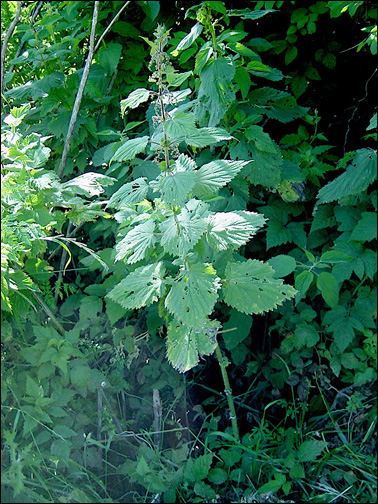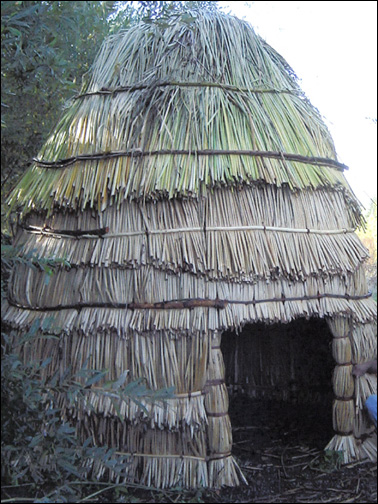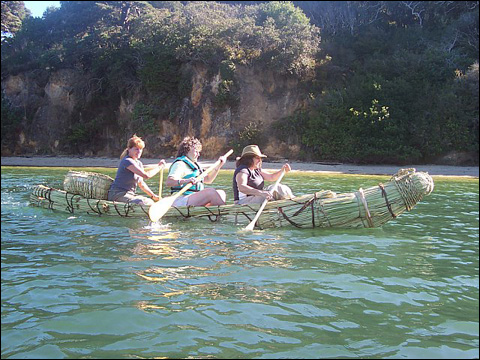
INSECTICIDES AND INSECT REPELLANTS
Pennyroyal (Mentha pulgium): This plant is an introduced species. It has been used as an insect repellant, and its extract can be fatally toxic if ingested by humans (Hickman 93:716).
Mugwort or Wormwood (Artemisia douglasiana): Dried leaves and stems were bundled to burn as a smudge or placed in a pillow to bring good dreams. It and California Bay were used by the Pomo to drive away insects from their acorn granaries (Stevens and Ryan 1997:30-31). This plant is pleasantly and strongly aromatic of sage (author).
California laurel, also known locally as Bay laurel and in Oregon as Oregon myrtle (Umbellularia californica): The strongly-aromatic leaves of bay were used by the Karuk. It was placed between layers of dried salmon to prevent insect (moth) infestation (Heizer & Elsasser 1980:85- 86). A. S. Taylor made similar observations along California’s North Coast where California laurel kept insects out of acorn granaries (Heizer & Elsasser 1980:98-99). Harrington’s notes indicate the Ohlone used it to freshen the air inside a house by hanging bunches of leaves inside. Smoke from burning leaves drove away fleas, and the smoke was also used to drive ground squirrels from their burrows (Bocek 1984:249). (see also Nuts, Bows)
California poppy (Eschscholzia californica): Ohlone boiled the flowers and used the liquid to kill hair lice (Timbrook 2007:86), (Bocek 1984:251).
DYE PLANTS
Datisca or Durango root (Datisca glomerata): The Ohlone used its root as a red or a yellow dye (Bocek 1984:250).
White alder (Alnus rombifolia): Ohlone used the bark to produce a dye (Bocek 1984:248). The bark is also used in dying basketry elements rusty red, but this was part of the basketry styles farther to the North (Shanks 2006:22-23) and not seen in Ohlone baskets. It may have been used to dye other materials (Timbrook 2007:64).
Tanoak (Lithocarpus densiflorus): Harrinton’s notes states the bark was used by Ohlone to make a dye (Bocek 1984:248).
Blue witch (Solanum spp.): The fruit was used to prepare a permanent blue dye used in tattoos (Bocek 1984:253). (See also Berries)
SURFACTANTS
Blue blossom (Ceanothus): An unspecified part of the plant was used by the Ohlone to produce a detergent for washing facial blemishes and for a shampoo (Bocek 1984:250). The blue blossoms can be wet and rolled vigorously in the hands to produce a good lather (author).
California goosefoot (Chenopodium californicum): Its roots were scraped and a detergent foam was produced with water (Bocek 1984:249) by the Ohlone.
Manroot, Wild cucumber, Chilicote (Marah macrocarpus): The Ohlone used the pounded root as a detergent. It produces a good lather (Bocek 1984:251). The root of these slender vines is large, often the size of a man’s torso.
Soap plant or Amole (Chlorogalum pomeridianum): The freshly mashed root could be worked into a lather to be used as soap or shampoo (nonspecific for California Indians) (Stevens & Ryan 1997:35). The Ohlone mashed the root to create a detergent for washing. The mashed stem was used as wash to reduce dandruff (Bocek1984:255). (See also Other Uses of Plants)
OTHER USES OF PLANTS
Big leaf maple (Acer macrophyllum): The plant was used by the Wintu to line hot rocks as acorn bread was cooked in an earth oven (Jacknis 2004:67). (See Seeds)
Bracken fern (Pteridium aquilinum): Large fronds were used by the Ohlone as umbrellas or roofing and as a lining for earth ovens or leaching pits. The root/rhizome was also used for hair care. A decoction of root was used as a hair rinse and a root paste was rubbed into the scalp to encourage hair growth (Bocek 1984:247, from Harrington’s notes). (See also Basketry)
California Buckeye (Aesculus californica): The Ohlone used the fruit for poisoning fish, so they could be caught (Timbrook 2007: 25), (Bocek 1984:252). (See also Nuts)
Cattail (Typha latifolia): For use in creating mats, rope, baskets, etc. The leaves are best gathered at the end of summer when the tips begin to brown (author from class notes/Beverly Ortiz). ( See also Geophytes.)
Coastal tarweed (Hemizonia corymbosa): The foliage was burned to drive ground squirrels from their burrows (Bocek 1984:254). (See also Seeds.)
Cottonwood (Populus spp): Harrington’s notes indicate the inner bark could be eaten (Bocek 1984:248). Harrington’s informants are Ohlone. (See also Vegetation.)
Deerweed (Lotus scoparius): It was sometimes used by the Ohlone as house thatching (Bocek 1984:250).
Giant vetch (Vicia gigantea): The foliage of this plant was said to be used by the Ohlone as a disguise when deer hunting (Bocek 1984:250).
Grass (unnamed spp): In the area of Pajaro River in 1772, Father Crespi notes some Ohlone homes were roofed with grass (Bean 1994:9).
Horsetail: (Equisetum spp): Bows, arrows and other objects were sanded to a fine polish using the silica-filled stems of these plants (Stevens and Ryan 1997:43-44). I have used this plant to polish wood and bone to a high sheen (author) (See also Basketry Plants.)
Mosses were used for padding in cushions and beds (Bocek 1984:247). This use may or may not have preceded western ideas about beds and cushions, this information comes from Ohlone Peoples living in the 1920s and 1930s (author).
Mugwort (Artemisia douglasiana): Branches were burned to stupefy bees and drive them from their nests, and as a torch when fishing at night (Bocek 1984:254). Though not documented for the Ohlone, the withered fall leaves can be rolled in the hands to produce a fine tinder capable of igniting a small coal (author).
Mule fat or Seep willow (Baccharis glutanosa): It was used in a wash for the scalp to encourage hair growth (Bocek 1984:254).
Oak (Quercus): Harrington’s notes indicate oak wood was used by the Ohlone for making utensils including bowls and mortars (Bocek 1984:248).
Oregon ash (Fraximus latifolia): Ohlone placed the leaf in their sandals to ward off rattlesnakes (Bocek 1989:250).
Plume thistles (Cirsium spp.): Stems eaten raw or boiled (Bocek 1984:254).
Poison oak (Toxicodendron diversiloba): Ohlone used the leaves to wrap bread (Bocek 1984: 251). This plant contains urushiol oil which causes contact dermatitis for anyone sensitive to the oil. The degree to which the Ohlone were affected is unknown, but there are many plants listed as a treatment for poison oak dermatitis, implying many individuals were sensitive to this plant (author).
Saltgrass (Distichlis spicata): Salt was gathered from the plant (Bocek 1984:255).
Snowberry (Symphocarpus alba): Used by the Ohlone to make brooms (Bocek 1984:254).
Soap plant or Amole (Chlorogalum pomeridianum): Fibers from the soap plant bulbs were used to make soap root brushes used in acorn processing and brushes used to brush the hair. A paste from the cooked bulb was applied in layers to create a tough handle on these brushes. The paste of the cooked bulb could also be used to seal the weave in twined burden baskets so they could be used to collect very small seeds. The same material could be used to glue sinew to their sinew-backed bows. The freshly mashed root was used to stupefy and capture fish (nonspecific for California Indians) (Stevens & Ryan 1997:35), (Ortiz 1991:75-84). The Ohlone made soap root brushes. They also mashed the root to create a fish poison. (Bocek 1984:255). Miwok made these brushes. The Chumash also made soap root brushes, but used asphaltum/tar to create the handle. Later, these brushes were designed for sale by the Chuimash with inlayed beads to make a decorative handle (Timbrook 2007:56-57). (See also Vegetation, Geophytes, and Surfactants.)
The Chumash used this bulb for tanning small hides. A fresh case-skinned fox pelt would be coated on the skin side with the soapy crushed root. After turning it so the fur side was again out, the skin was manipulated with the hands, and dried in its natural shape. Soap plant was not used with deer (Timbrook 2007:57).
Stinging nettle (Urtica dioica): A number of Indian groups (including the Ohlone) struck their skin with nettles to relieve the pain of rheumatism, old age, or paralysis (Timbrook 2007:223), (Bocek 1984:250).

Stinging nettle
Sword fern (Polystichum munitum ssp. munitum): Harrington’s notes indicate the fronds were used by the Ohlone to line earth ovens (Bocek 1984:247).
Tobacco (Nicotiana spp.) (Nicotiana bigelovii): Stephen Powers notes the use of tobacco for smoking, but not for chewing (nonspecific California Indian group). In this entry, Powers, who often speaks of Native Peoples in the disparaging language of his time, defends them against those who imply tobacco is, for them, a vice. He notes the Klamath were cultivating the plant. A pipe is the usual means of smoking tobacco among Native Californians (Powers 1976:415, 422, 428). Several stone pipes for smoking were given to the Spanish by the Ohlone when early contact was made in 1772 (Bean 1994:16). Harrington’s notes document the use of Nicotiana bigelovii by the Ohlone. It was smoked in a social/ritual context (Bocek 1984:253). The Ohlone apparently mixed lime from seashells with tobacco and ate it, producing a kind of intoxication and vomiting. Tobacco was planted and tended by many Native groups (Heizer & Alsasser 1980:143).
Tule (Shoenoplectus, synonym: Scirpus acutus): Its use by Ohlone Peoples to thatch their homes is documented near San Lorenzo Creek in 1772 by Father Juan Crespi (Bean 1994:9, 11-13). Harrington’s notes indicate it was used by the Ohlone for their tule balsas (rafts), and the hollow stem was sometimes used to create a pipe stem. However, this pipe stem was considered inferior to ones made of elderberry (Bocek 1984:255). (See also Geophytes, Basketry)
In the diary of Father Juan Crespi, the use of tule in the construction of boats is noted in lakes near the Pajaro River (Bean 1994:9, 11-13) and on the Carquinez Straights (Bean 1994:20). Louis Choris drew an illustration of an Ohlone boat.
The stalks are best gathered at the peak of their growth in June or July (author: from class notes/Beverly Ortiz). Other California groups used it for clothing: skirts, shoes (Clear Lake), and baskets when gathered early. If gathered late, they were used for boats. A third of the width (diameter) is lost in drying. Samuel Barret commissioned a tule boat constructed with grape vine binding. Spiral binding was not used in California. The Ohlone boat had 13 bindings (author, from 11/06/05 CNPS lecture by Charles Kennard). The Pomo used the vine as a lashing for their tule balsas (Vinson & Andrews1969:28).

Tule house

Tule balsa
Turkey mullin (Eremocarpus setigerus): The Ohlone used its crushed roots to stupefy fish, placing it in freshwater pools or dammed streams, then gathering the fish (Bocek 1984:249).
Western sycamore (Platanus racimosa): Ohlone wrapped acorn bread with sycamore leaves during baking (Timbrook 2007:149), (Bocek 1984:249).
Western vervain (Verbena lasiostachys): It was used for medicinal tea (Bocek 1984:253).
Wood fern or shield fern (Dryopteris arguta): The fronds were steeped like a tea and the liquid used as a hair wash (Bocek 1984:247).
Wild grape (Vitus californica): Pomo, Hupa and Miwok used grape leaves to wrap foods for cooking in earth ovens (Jacknis 2004: 69).
Wild tarragon, wormwood (Artemisia dranunculus): This native plant was used by the Ohlone as a torch when fishing at night (Bocek 1984:254).
Willow: (Salix spp): Their neighbors, the Yokuts, constructed the inner frame of their tule homes with willow (Heizer and Elsasser 1980:67). Ohlone homes also were constructed with an inner framework made of willow. The bark could also be braided into rope, and dry branches were prepared for kindling (Bocek1984:249). (See Basketry Plants)
![]()
Photographs by Susan Labiste. All photo rights reserved.
We hope the information on the PrimitiveWays website is both instructional and enjoyable. Understand that no warranty or guarantee is included. We expect adults to act responsibly and children to be supervised by a responsible adult. If you use the information on this site to create your own projects or if you try techniques described on PrimitiveWays, behave in accordance with applicable laws, and think about the sustainability of natural resources. Using tools or techniques described on PrimitiveWays can be dangerous with exposure to heavy, sharp or pointed objects, fire, stone tools and hazards present in outdoor settings. Without proper care and caution, or if done incorrectly, there is a risk of property damage, personal injury or even death. So, be advised: Anyone using any information provided on the PrimitiveWays website assumes responsibility for using proper care and caution to protect property, the life, health and safety of himself or herself and all others. He or she expressly assumes all risk of harm or damage to all persons or property proximately caused by the use of this information.
© PrimitiveWays 2016